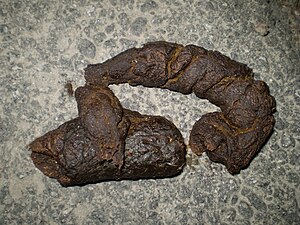 Image via Wikipedia
Image via WikipediaThe Host Community Standing Committee (HCSC) also ignored a request for an Environmental Impact Assessment, although the HCSC chairperson did ask the grant writer if he noted the request. He did. They unanimously voted fund the dog park regardless.
Here are some dog park statistics and their environmental impacts. The document provided was produced at the request of the Planning and Development Depart in Lowell, Mass. It can be read HERE. Below is a summary of the document written by Dillon Sussman of the Conway School of Landscape Design.
Aesthetic Issues of Dog Waste
1. It's unsightly, smelly, and messy
2. Dog waste can spread harmful bacteria and parasites
3. Excess nutrients are released from dog waste creating "nutrient pollution."
Dog waste is cited as the 3rd or 4th largest contributor of bacterial pollution in urban watersheds. E coli, salmonella and giardia readily infect humans and can cause serious illness or death. Parasites: hookworms, roundworms, and tapeworms can be passed from dog feces to humans. Typically transmission occurs when skin comes into contact with the larva. Roundworm eggs can’t be seen by human eyes. They hatch in human intestines and attacks can include attacking the retina, causing blindness.
Each gram of dog feces can contain 23 million fecal coliform colonies.
A study done at a Seattle watershed found 20 percent of bacteria in water could be attributed to dogs (EPA, 2001).
Dog feces has higher phosphorous rates than that found in cow manure, broiler chicken litter or swine manure.
Anyone that owns a dog knows urine burns grass. It contains nitrogen. The higher the concentration and more frequently applied, the worse the problem becomes. The contaminated runoff can lead to serious water quality problems.
The EPA says nutrient pollution is “worthy of environment concern." Nutrient pollution has consistently ranked as one of the top causes of degradation in some US waters for more than a decade. (EPA website, 2008)
Dog parks may amplify the aesthetic, sanitary and environmental problems caused by dog waste by concentrating it in smaller areas. (Lewiston fenced 1.3 acres for approximately 1,600 dogs.)
Most smaller dog parks host 50 dogs at a time and they are often overrun with dog droppings. A 1998 Los Angeles study counted 2,000 dogs using a 3 /4 acre park in a single week. The average dog produces 3 /4 pounds of poop every day. 1,000 dogs doing their daily duty in a park will produce 750 pounds of excrement in a week. The park will be speckled with approximately 1 poop every 33 square feet. There isn’t room for it to decompose as it does in the open. Even if picked up and removed it may leave bacteria and parasites behind.
Why the dog park is an item of concern for the grassland habitat at the Lewiston (NY) Plateau Wildlife Refuge located on the Niagara River Gorge Rim.
The negative effects of excess nutrients in a Boulder, Colorado dog park found that native grasses, which are accustomed to low nitrogen levels were unable to compete with nitrogen-loving exotic-invasive species that flourished when dog waste increased on the site (Watson, 2002)Environmental Impact of Dog Waste
San Francisco recently determined that pet waste accounted for 4 percent of their residential waste stream (Jones, 2006)
Typically, dog waste is picked up in plastic bags and taken to a landfill. Plastic bags do not decompose for decades, effectively mummifying the waste and taking up valuable landfill space. Dog waste decomposition also produces methane, a greenhouse gas more potent than carbon dioxide.
Flushing dog feces down the toilet has mixed results. Many wastewater facilities are already over taxed and are unable to process the waste. Some found dog feces to be very hard; it blocked their machinery.
It’s possible to mitigate the harmful effects of a dog park, however, it hinges on dog park surfaces and water handling. Few dog park designers seem to consider where the contaminated water will go once it leaves the park’s fence. Decomposed granite is popular. It’s impervious to water. It must be watered to keep the dust down, but it runs off the surface carrying fecal and urinary residue with it.
Regular watering, intensive mowing regimens, overseeding, and fertilization may help maintain a grassy surface. Periodic closure of a dog park gives grass time to recover. (Arvasin, 2003, Burkhardt, date unknown)
There's no water at the Lewiston Plateau.

No comments:
Post a Comment